Median
| Author:Laxman Burdak, IFS (Retd.) |
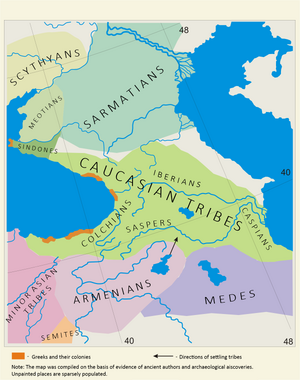
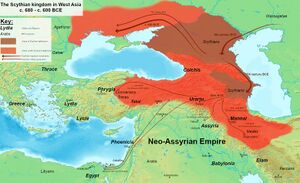
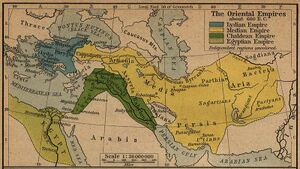
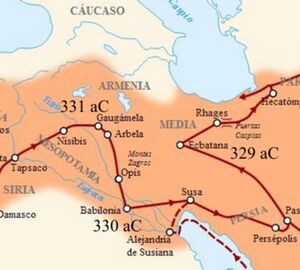
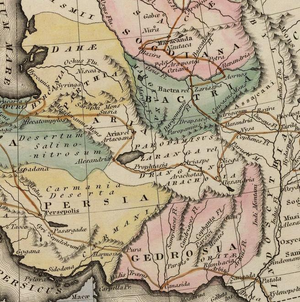
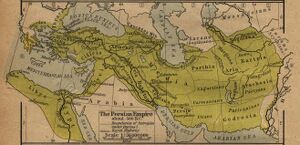
Median or Mede or Medes were an ancient Iranian people who lived in Media, in the northwest of present-day Iran and and south-east Turkey. Historians[1] have proved that Median Empire was nothing but Manda Empire, ruled by Manda Jat clan.
Variants of name
- Mēdia and Medes (Anabasis by Arrian, p. 91, 125, 155, 161, 171, 179, 180, 192, 194, 239, 272, 273, 308, 365, 374, 387, 393.)
- Median
- Medians
- Mede
- Medes
- Madai
Jat Gotras Namesake
- Manda = Media (Pliny.vi.16, Pliny.vi.17, Pliny.vi.25, Pliny.vi.28, Pliny.vi.29, Pliny.vi.31, Pliny.vi.39) [2]
Jat Gotras Namesake
- Manda = Mēdia and Medes (Anabasis by Arrian, p. 91, 125, 155, 161, 171, 179, 180, 192, 194, 239, 272, 273, 308, 365, 374, 387, 393.)
- Mada (मदा) (Jat clan) → Madai (मड़ई) village in Harrai tahsil in Chhindwara district of Madhya Pradesh.
Origin of name
The Hebrew name for Media is Madai, which means middle-land. The Greeks called the country Media, according to Polybius (v. 44), because it lies near the middle of Asia.[3]
Mention by Pliny
Pliny[4] mentions 'Media and the Caspian Gates'....Ecbatana1, the capital of Media, was built2 by king Seleucus, at a distance from Great Seleucia of seven hundred and fifty miles, and twenty miles from the Caspian Gates.
The remaining towns of the Medians are Phazaca, Aganzaga, and Apamea,3 surnamed Rhagiane.
1 A city of great magnitude, pleasantly situate near the foot of Mount Orontes, in the northern part of Greater Media. Its original foundation was attributed by Diodorus Siculus to Semiramis, and by Herodotus to Deioces. It was the capital of the Median kingdom, and afterwards the summer residence of the Persian and Parthian kings. The genuine orthography of the name seems to be Agbatana. The ruins seen at the modern Hamadan are generally supposed to represent those of the ancient Ecbatana; but it is most probable that at different times, if not contemporaneously, there were several cities of this name in Media.
2 Pliny in this statement, as also in the distances which he here assigns to Ecbatana, is supposed to have confounded Ecbatana with Europus, now Veramin, rebuilt by Seleucus Nicator.
3 This was a city in the vicinity of Rhagæ, which was distant about 500 stadia from the Caspian Gates. It was built by the Greeks after the Macedonian conquest of Asia. The other places here mentioned do not appear to have been identified.
Mention by Pliny
Pliny[5] mentions 'Media and the Caspian Gates'....On the other side8 of these gates (Caspian Gates) we come to the deserts9 of Parthia and the mountain chain of Cithenus; and after that, the most pleasant locality of all Parthia, Choara10 by name. Here were two cities of the Parthians, built in former times for their protection against the people of Media, Calliope,11 and Issatis, the last of which stood formerly12 on a rock. Hecatompylos,13 the capital of Parthia, is distant from the Caspian Gates one hundred and thirty-three miles. In such an effectual manner is the kingdom of Parthia shut out by these passes.
8 To the south-east of them.
9 Mentioned in c. 29 of the present Book.
10 Or Choarene.
11 Its site is unknown; but it is mentioned by Appian as one of the many towns erected by Seleucus.
12 By the use of the word "quondam," he implies that in his time it was in ruins.
13 A place of considerable importance, which seems to have derived its name from its "hundred gates." It was one of the capitals of the Arsacidan princes; but, extensive though it may have been, there is great doubt where it was situate, the distance recorded by ancient writers not corresponding with any known ruins.
Mention by Pliny
Pliny[6] mentions The Parthian Empire....It is requisite in this place to trace the localities of the Medi also, and to describe in succession the features of the country as far as the Persian Sea, in order that the account which follows may be the better understood. Media8 lies crosswise to the west, and so presenting itself obliquely to Parthia, closes the entrance of both kingdoms9 into which it is divided.
It has, then, on the east, the Caspii and the Parthi; on the south, Sittacene, Susiane, and Persis; on the west, Adsiabene; and on the north, Armenia.
8 Media occupied the extreme west of the great table-land of the modern Iran. It corresponded very nearly to the modern province of Irak-Ajemi.
9 The Upper and the Lower, as already mentioned.
History
Aryan people: The Median people are mentioned by that name in many ancient texts. According to the Histories of Herodotus;[7]
- "The Medes were called anciently by all people Aryans; but when Medea, the Colchian, came to them from Athens, they changed their name. Such is the account which they themselves give."
Historical geography of Media: The original population area of the Median people was western Iran and named after them as "Media". At the end of the 2nd millennium BCE the Median tribes emerged in the region (one of several Iranian tribes to do so) which they later called Media. These tribes expanded their control over larger areas subsequently, and, over a period of several hundred years, the boundaries of Media moved.[8]
Kurds and Medes: The Russian historian and linguist Vladimir Minorsky suggested that the Medes, who widely inhabited the land where currently the Kurds form the majority, might have been forefathers of the modern Kurds. He also claims that the Medes who invaded the region in the eighth century B.C.E., linguistically resembled the Kurds. This view was accepted by many Kurdish nationalists in the twentieth century. However, Martin van Bruinessen, a prominent Dutch scholar, argues against the attempt to take the Medes as ancestors of the Kurds.[9]
It is important to note that in Roman sources the Parthians are described as a unification of Medes and Scythians. Their costumes,culture and language are described as a mixture of both with increase of power being more like that of the Medes.[10]
Median Empire was the Manda Empire
Ujagar Singh Mahil [11] writes that Median Empire was nothing but Manda Empire as proved below quoted from his book section 4 from Chapter-1.
Section 4 : Philological Mistake - This mistake is so important in connection with contents of this book that I must write in detail about it. In a succeeding chapter will be described the important Jat Empire of Manda. When in the course of a few generations the wheel of fortune turned, a Persian prince with Jat blood flowing in his veins succeeded to that Jat Empire. The laws, the administration and the army, however, remained Jat. Even the Commander-in-Chief of the army, Harpagus, was the same Jat- who had previously conquered so many countries under the Manda Empire. Only the Emperor, the head of the Empire, was Persian. The name of the Empire was, however, changed into Manda and Persian Empire.
In course of time the word Manda happened by a mere philological mistake, to be changed into Mede. There is no possible means of knowing when and how this serious mistake occurred and who was responsible for this mistake. Media was the northwestern neighbor of Manda. It was eventually annexed to the Empire of Manda. This might be the reason of the mistake. The Medes never had any Empire. They were Greek traders and moneylenders living in small principalities. Such people would never dream to have any Empire or history. What history can a trader or a moneylender have except that of being raided by the greedy neighbors for his riches? They were at first raided by the Assyrians and eventually Shalmaneser, the king of Assyria, took tribute from them. Afterwards their Jat neighbors raided them and their country was annexed to Manda Empire as mentioned above. Confounding the brave Manda with the effete Medes was most unfortunate event in history. The mistake became so prevalent that even a proverb was invented in English language to the effect that a certain thing is as unchangeable as the laws of media and Persians.
This mistake was detected when the monuments of Nabonidus and Cyrus were unearthed. It was then discovered that upto that time the whole history remained based upon a most unfortunate philological mistake. It was under the influence of that mistake that Cyaxares, one of the bravest Jat Emperors who was responsible for the tragic end of Nineveh, was described as a median prince.
I must quote here Professor Sayce, a brilliant English professor of 19th century who was the author of the well-known book "Ancient Empires of the East". He says as follows: —
- "When in generation which succeeded Darius Hystaspes, Cyrus became the founder of the Persian Empire, the Medes and the Manda were confounded one with the other. Astyages, the suzerain of Cyrus, was transformed into a Mede and the city of Ecbatana into the capital of a Median Empire. The illusion has lasted down to our own age. There was no reason for doubting the traditional story; neither in the pages of the writers of Greece and Rome, nor in those of the Old Testament, nor even in the great inscription of Darius in Behistun did there seem to be anything to cast suspicion upon it. It was not until the discovery of the monuments of Nabonidus and Cyrus that the truth at last came to light and it was found that the history we had so long believed was founded upon a philological mistake."
In this connection I must also give here a quotation from page 573 volume II of the Historians' History of the World: —
- " So startling and revolutionizing is the knowledge obtained from the deciphering of Assyria And a Persian monument, so wholly different is the historical aspect thus revealed that the term median Empire is probably destined to disappear from the historians' phraseology. Indeed, Professor Sayce in his latest writings has discarded it."
This discarding of a wrong word has not, however, dispelled the illusion from the writings of the 20th century historians. Even Mr. H. G. Wells, in his well known book "The Outline of History", uses the wrong term Mede in so many places. I, therefore, agree with the opinion of the authors of Historians' History of the World on page 582, Volume II, that the phrase having been universally used throughout centuries cannot so easily be discarded. I, therefore, propose the only desperately effective measure. Wherever the word Mede occurs in literature, ancient or modern, it must be taken to mean Manda Jat.
This arrangement does not do any harm to anybody; because, the real Medes had neither any history, nor any other kind of literature excepting what was imputed to them by the Great mistake. It will no doubt amount to undeserved perpetuation of their name, but it cannot be helped under the circumstances, because the only other alternative is the perpetual confusion in so important a part of ancient history. I, therefore, propose in the succeeding pages to consider the word Medes as meaning Manda Jats.
Bhim Singh Dahiya[12] writes...Up to the nineteenth century, this brilliant empire was called the "Empire of the Medes". It was so called by the Greek writers as well as in the Old Testament. The country of the Medes, called Media, was the north western neighbour of the Mandas-the actual name of the empire builders. Even Media was eventually annexed to the empire of Manda. This was perhaps the reason of the serious mistake of history where the Mandas and the Medes were confused With each other. The Medes were traders of Greek stock and were living in small principalities. They never had any empire. Confounding the brave Mandas with the effete Medes was the most unfortunate event in history. The mistake become so prevalent that even a proverb was invented in English equal to the effect that a certain thing is as unchangeable-as the laws of Medes and Persians.
The mistake was detected when the monuments of Nabonodus and Cyrus were unearthed. It was then discovered that the whole history was based upon a philological mistake. It was found that the name of the empire and its people, was not Medes but Manda. In the words of Prof. Sayce, in his well known book, Ancient Empires of The East; "when in two generations which succeeded Darius Hystaspes, Cyrus, became the founder of the present empire, the Medes and the Manda were confounded, one with the other. Astyages, the suzerain of Cyrus, was transformed into a Mede and the city of Ecbatana, into the capital of a Median empire. The illusion has lasted down to our own age. There was no reason for doubting the traditional story, neither in the pages of the writers of Greece and Rome, nor in those of the old testament, nor even in the great inscriptions of Darius in Behistun, did there seem to, be anything to cause suspicion upon it. It was not until the discovery of the monuments of Nabonodus and Cyrus, when the truth at last came to light and it was found that the history we have so long believed was founded upon a philological mistake". After this mistake was detected efforts were made to correct it and the Historians' History of the World observes: "so startling and revolutionising is the knowledge obtained from the decipherments of Assyrian and Persian monuments, so wholly different is the historical aspect thus revealed, that the term Median empire is probably destined to disappear from the historian's phrageology. Indeed Prof. Sayce in his latest writing has discarded it [13]."
Ch.8 Description of Darius-III's Army at Arbela against Alexander
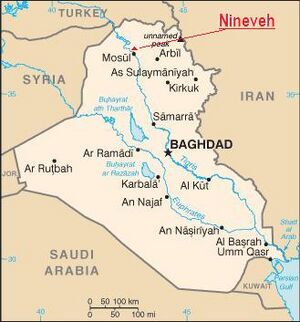
They come to the aid of Darius-III (the last king of the Achaemenid Empire of Persia) and were part of alliance in the battle of Gaugamela (331 BC) formed by Darius-III in war against Alexander the Great at Arbela, now known as Arbil, which is the capital of Kurdistan Region in northern Iraq.
Arrian[14] writes....Alexander therefore took the royal squadron of cavalry, and one squadron of the Companions, together with the Paeonian scouts, and marched with all speed; having ordered the rest of his army to follow at leisure. The Persian cavalry, seeing Alexander, advancing quickly, began to flee with all their might. Though he pressed close upon them in pursuit, most of them escaped; but a few, whose horses were fatigued by the flight, were slain, others were taken prisoners, horses and all. From these they ascertained that Darius with a large force was not far off. For the Indians who were conterminous with the Bactrians, as also the Bactrians themselves and the Sogdianians had come to the aid of Darius, all being under the command of Bessus, the viceroy of the land of Bactria. They were accompanied by the Sacians, a Scythian tribe belonging to the Scythians who dwell in Asia.[1] These were not subject to Bessus, but were in alliance with Darius. They were commanded by Mavaces, and were horse-bowmen. Barsaentes, the viceroy of Arachotia, led the Arachotians[2] and the men who were called mountaineer Indians. Satibarzanes, the viceroy of Areia, led the Areians,[3] as did Phrataphernes the Parthians, Hyrcanians, and Tapurians,[4] all of whom were horsemen. Atropates commanded the Medes, with whom were arrayed the Cadusians, Albanians, and Sacesinians.[5] The men who dwelt near the Red Sea[6] were marshalled by Ocondobates, Ariobarzanes, and Otanes. The Uxians and Susianians[7] acknowledged Oxathres son of Aboulites as their leader, and the Babylonians were commanded by Boupares. The Carians who had been deported into central Asia, and the Sitacenians[8] had been placed in the same ranks as the Babylonians. The Armenians were commanded by Orontes and Mithraustes, and the Cappadocians by Ariaoes. The Syrians from the vale between Lebanon and Anti-Lebanon (i.e. Coele-Syria) and the men of Syria which lies between the rivers[9] were led by Mazaeus. The whole army of Darius was said to contain 40,000 cavalry, 1,000,000 infantry, and 200 scythe-bearing chariots.[10] There were only a few elephants, about fifteen in number, belonging to the Indians who live this side of the Indus.[11] With these forces Darius had encamped at Gaugamela, near the river Bumodus, about 600 stades distant from the city of Arbela, in a district everywhere level;[12] for whatever ground thereabouts was unlevel and unfit for the evolutions of cavalry, had long before been levelled by the Persians, and made fit for the easy rolling of chariots and for the galloping of horses. For there were some who persuaded Darius that he had forsooth got the worst of it in the battle fought at Issus, from the narrowness of the battle-field; and this he was easily induced to believe.
1. Cf. Aelian (Varia Historia, xii. 38).
2. Arachosia comprised what is now the south-east part of Afghanistan and the north-east part of Beloochistan.
3. Aria comprised the west and north-west part of Afghanistan and the east part of Khorasan.
4. Parthia is the modern Khorasan. Hyrcania was the country south and south-east of the Caspian Sea. The Tapurians dwelt in the north of Media, on the borders of Parthia between the Caspian passes. Cf. Ammianus, xxiii. 6.
5. The Cadusians lived south-west of the Caspian, the Albanians on the west of the same sea, in the south-east part of Georgia, and the Sacesinians in the north-east of Armenia, on the river Kur.
6. "The Red Sea was the name originally given to the whole expanse of sea to the west of India as far as Africa. The name was subsequently given to the Arabian Gulf exclusively. In Hebrew it is called Yam-Suph (Sea of Sedge, or a seaweed resembling wool). The Egyptians called it the Sea of Weeds.
7. The Uxians occupied the north-west of Persis, and Susiana was the country to the north and west of Persis.
8. The Sitacenians lived in the south of Assyria. ἐτετάχατο. is the Ionic form for τεταγμἑνοι ἦσαν.
9. The Greeks called this country Mesopotamia because it lies between the rivers Euphrates and Tigris. In the Bible it is called Paddan-Aram (the plain of Aram, which is the Hebrew name of Syria). In Gen. xlviii. 7 it is called merely Paddan, the plain. In Hos. xii. 12, it is called the field of Aram, or, as our Bible has it, the country of Syria. Elsewhere in the Bible it is called Aram-naharaim, Aram of the two rivers, which the Greeks translated Mesopotamia. It is called "the Island," by Arabian geographers.
10. Curtius (iv. 35 and 45) states that Darius had 200,000 infantry, 45,000 cavalry, and 200 scythed chariots; Diodorus (xvii. 53) says, 800,000 infantry, 200,000 cavalry, and 200 scythed chariots; Justin (xi. 12) gives 400,000 foot and 100,000 horse; and Plutarch (Alex., 31) speaks of a million of men. For the chariots cf. Xenophon (Anab., i 8, 10); Livy, xxxvii. 41.
11. This is the first instance on record of the employment of elephants in battle.
12. This river is now called Ghasir, a tributary of the Great Zab. The village Gaugamela was in the district of Assyria called Aturia, about 69 miles from the city of Arbela, now called Erbil.
Ch. 19: Darius pursued into Media and Parthia
Arrian[15]After bringing these matters to a successful issue, he advanced towards Media; for he ascertained that Darius was there. Now Darius had formed the resolution, if Alexander remained at Susa or Babylon, to stay there among the Medes, in order to see if any change of policy were made by Alexander. But if the latter marched against him, he resolved to proceed into the interior towards Parthia and Hyrcania, as far as Bactria, laying waste all the land and making it impossible for Alexander to advance any further. He therefore sent the women and the rest of the property which he still retained, together with the covered carriages, to what were called the Caspian Gates[1]; but he himself stayed at Ecbatana,[2] with the forces which had been collected from those who were at hand. Hearing this, Alexander advanced towards Media, and invading the land of the Paraetacae,[3] he subdued it, and appointed Oxathres, son of Abulites, the former viceroy of Susa, to rule as viceroy. Being informed on the march that Darius had determined to meet him for battle, and to try the fortune of war again (for the Scythians and Cadusians had come to him as allies), he ordered that the beasts of burden, with their guards and the rest of the baggage, should follow; and taking the rest of his army, he led it in order of battle, and on the twelfth day arrived in Media. There he ascertained that the forces of Darius were not fit for battle, and that his allies, the Cadusians and Scythians, had not arrived; but that he had resolved to flee. He therefore marched on with still greater speed; and when he was only three days' journey from Ecbatana, he was met by Bistanes, son of Ochus, who reigned over the Persians before Darius. This man announced that Darius had fled five days before, taking with him 7,000 talents of money[4] from the Medes, and an army of 3,000 cavalry and 6,000 infantry.
When Alexander reached Ecbatana, he sent the Thessalian cavalry and the other Grecian allies back to the sea, paying them the full hire which had been stipulated, and making them an additional donation from himself of 2,000 talents. He issued an order that if any man of his own accord wished still to continue to serve for hire with him, he should enlist; and those who enlisted in his service were not a few. He then ordered Epocillus, son of Polyeides, to conduct the rest down to the sea, taking other cavalry as a guard for them, since the Thessalians sold their horses there. He also sent word to Menes to take upon himself the duty of seeing that they were conveyed in triremes to Euboea, when they arrived at the sea.[5] He instructed Parmenio to deposit the money which was being conveyed from Persis in the citadel at Ecbatana, and to hand it over to the charge of Harpalus;[6] for he had left this man over the money with a guard of 6,000 Macedonians and a few horsemen and light-armed infantry to take care of it. He told Parmenio himself to take the Grecian mercenaries, the Thracians, and all the other horsemen except the Companion cavalry, and march by the land of the Cadusians into Hyrcania. He also sent word to Clitus, the commander of the royal squadron of cavalry, who had been left behind at Susa ill, that when he arrived at Ecbatana from Susa he should take the Macedonians who had been left there in charge of the money, and go in the direction of Parthia, where also he himself intended soon to arrive.
1. This was the principal pass through the Elburz mountains from Media into Hyrcania and Parthia.
2. This was the capital of Media, called in Chaldee Achmetha (Ezra vi. 2). The present city of Hamadan is on the same site. It is situated at the foot of Mount Orontes, and was used by the Persian and Parthian kings as their summer residence. It was surrounded by seven walls, each overtopping the one before it, from the outer to the inner, crowned with battlements of different colours. Its citadel was used as a royal treasury. Below it stood a splendid palace, with silver tiles, and adorned with wainscotings, capitals, and entablatures of gold and silver. These treasures, to the value of 4,000 talents, were coined into money by Antiochus the Great of Syria. See Herodotus, i. 98; Polybius, x. 27.
3. This tribe lived in the mountains between Media and Persis.
4. £1,700,000.
5. Curtius (v. 23) says that 6,000 Grecian mercenaries under Plato the Athenian met Alexander in Media, having marched up from Cilicia.
6. Diodorus (xvii. 80) says that the amount of treasure deposited at Ecbatana was 180,000 talents or £41,400,000.
जाट इतिहास
डॉ रणजीतसिंह[16] लिखते हैं....जाटों के विस्तार की पुष्टि एंटीक्विटी ऑफ जाट रेस के लेखक उजागर सिंह महल के विचारों से भी होती है। महल महोदय अपनी पुस्तक में लिखते हैं - "मैं अब विशालतम जाट साम्राज्य का वर्णन करता हूं जो कि मात्र भौगोलिक सीमाओं के कारण ही बड़ा नहीं था, अपितु इजिप्ट और असीरिया के साम्राज्यों से भी बड़ा था। यह स्मरण रखना चाहिए कि पर्शियन साम्राज्य जाट साम्राज्य की देन है और पर्शियन राजाओं में जाट रक्त विद्यमान है। जाटों के इस साम्राज्य को मेड़ा साम्राज्य कहते हैं[17] महल के मतानुसार जाटों ने रोमन साम्राज्य, स्पेन और ब्रिटेन तक को जीता था [18] [पृष्ठ.5]: इससे आगे वे लिखते हैं ....:"यूरोप की डेन्यूब नदी जाटों के पुरातात्विक इतिहास की दृष्टि से बड़ी महत्वपूर्ण है। इस नदी के दोनों किनारों पर जाट ही निवास करते थे। डेन्यूब नदी जाटों से इतनी संबंधित है कि वह उनके स्वप्नों में भी आती है।"
सिकंदर महान ने अपने एशिया आक्रमण के समय सोगड़ियाना (तुर्किस्तान) पर आक्रमण किया था। उस समय सोगड़ियाना की राजधानी समरकंद थी। उजागर सिंह के विचार अनुसार यह प्रदेश उस समय जाटों के अधीन था जो कि पंजाब के जाटों के बहुत दूर के पूर्वज थे।
External links
See also
References
- ↑ Ujagar Singh Mahil: Antiquity of the Jat race, Delhi (1954), sec.4, Ch.1
- ↑ Bhim Singh Dahiya, Jats the Ancient Rulers, p. 128
- ↑ The Anabasis of Alexander/4b, Ch.18, f.n.1
- ↑ Natural History by Pliny Book VI/Chapter 17
- ↑ Natural History by Pliny Book VI/Chapter 17
- ↑ Natural History by Pliny Book VI/Chapter 29
- ↑ Herodotus 7.62.1
- ↑ Diakonoff, I. M. (1985), "Media", The Cambridge History of Iran 2 (Edited by Ilya Gershevitch ed.), Cambridge, England: Cambridge University Press, pp. 36–148, ISBN 0-521-20091-1
- ↑ Hakan Özoğlu, Kurdish notables and the Ottoman state: Evolving Identities, Competing Loyalties, and Shifting Boundaries, SUNY Press, 2004, p. 25.
- ↑ A Roman description of the Parthians or later Persians from Justin's History of the World BOOK XLI
- ↑ Antiquity of the Jat race, Delhi (1954), sec.4, Ch.1
- ↑ Bhim Singh Dahiya:Jats the Ancient Rulers (A clan study)/The Mandas, p.128-129
- ↑ 2. Vol. II,p.73
- ↑ The Anabasis of Alexander/3a, Ch.8
- ↑ Arrian: The Anabasis of Alexander/3b, Ch.19
- ↑ Jat Itihas By Dr Ranjit Singh/1.Jaton Ka Vistar, pp.4-5
- ↑ एंटीक्विटी ऑफ जाट रेस, पृष्ठ 9-7 ?
- ↑ एंटीक्विटी ऑफ जाट रेस, पृष्ठ 53-66

